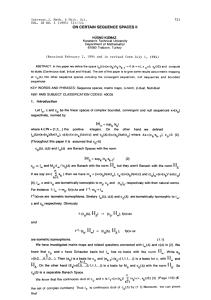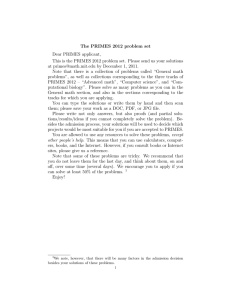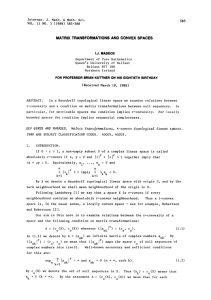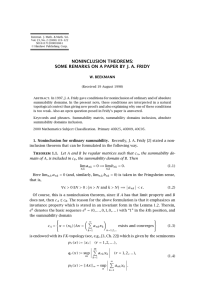Document 10942005
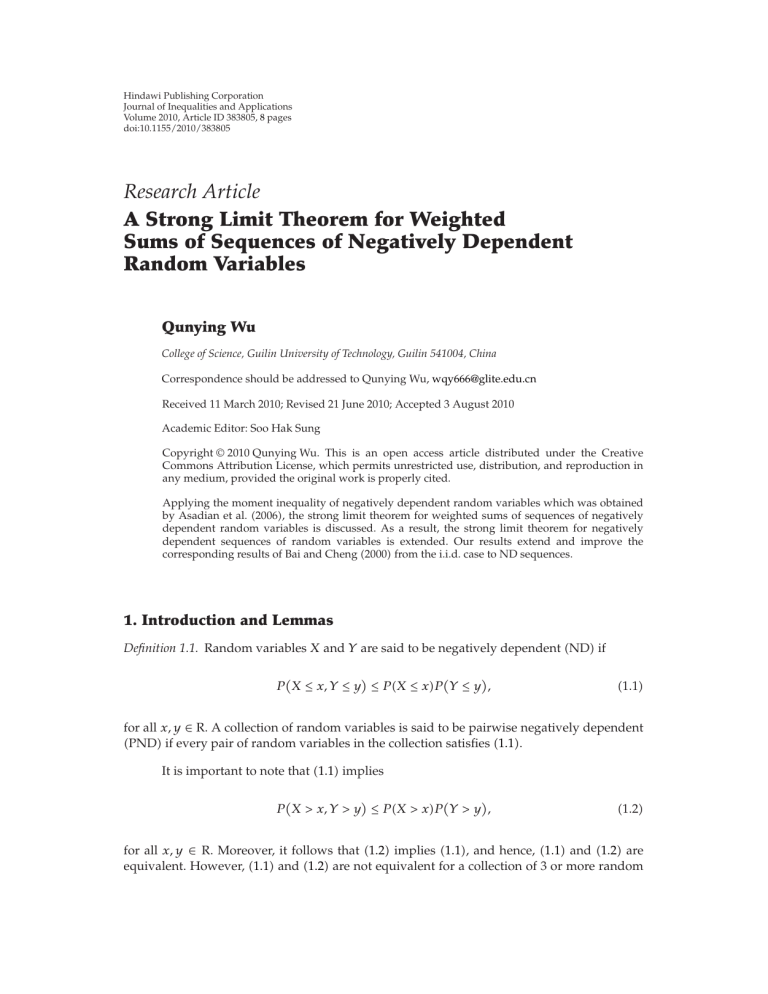
Hindawi Publishing Corporation
Journal of Inequalities and Applications
Volume 2010, Article ID 383805, 8 pages doi:10.1155/2010/383805
Research Article
A Strong Limit Theorem for Weighted
Sums of Sequences of Negatively Dependent
Random Variables
Qunying Wu
College of Science, Guilin University of Technology, Guilin 541004, China
Correspondence should be addressed to Qunying Wu, wqy666@glite.edu.cn
Received 11 March 2010; Revised 21 June 2010; Accepted 3 August 2010
Academic Editor: Soo Hak Sung
Copyright q 2010 Qunying Wu. This is an open access article distributed under the Creative
Commons Attribution License, which permits unrestricted use, distribution, and reproduction in any medium, provided the original work is properly cited.
Applying the moment inequality of negatively dependent random variables which was obtained by Asadian et al.
2006 , the strong limit theorem for weighted sums of sequences of negatively dependent random variables is discussed. As a result, the strong limit theorem for negatively dependent sequences of random variables is extended. Our results extend and improve the corresponding results of Bai and Cheng 2000 from the i.i.d. case to ND sequences.
1. Introduction and Lemmas
Definition 1.1. Random variables X and Y are said to be negatively dependent ND if
P X ≤ x, Y ≤ y ≤ P X ≤ x P Y ≤ y , 1.1
for all x, y ∈ R. A collection of random variables is said to be pairwise negatively dependent
PND if every pair of random variables in the collection satisfies 1.1
.
It is important to note that 1.1
implies
P X > x, Y > y ≤ P X > x P Y > y , 1.2
for all x, y ∈ R. Moreover, it follows that 1.2
implies 1.1
, and hence, 1.1
and 1.2
are equivalent. However, 1.1
and 1.2
are not equivalent for a collection of 3 or more random
2 Journal of Inequalities and Applications variables. Consequently, the following definition is needed to define sequences of negatively dependent random variables.
Definition 1.2. The random variables X
1 for all real x
1
, . . . , x n
,
, . . . , X n are said to be negatively dependent ND if
⎛
P ⎝ n j 1
⎛
P
⎝ n j
1
X j
≤ x j
X j
> x j
⎞
⎠ ≤ n
P X j j 1
⎞
⎠
≤ n
P X j j
1
≤ x j
> x j
,
.
1.3
An infinite sequence of random variables
{ X n
X
1
, . . . , X n is ND.
; n ≥
1
} is said to be ND if every finite subset
Definition 1.3. Random variables X
1
, X
2
, . . . , X
NA if for every pair of disjoint subsets
A
1 n
, n ≥ 2 are said to be negatively associated and
A
2 of
{
1
,
2
, . . . , n }
, cov f
1
X i
; i ∈ A
1
, f
2
X j
; j ∈ A
2
≤ 0 , 1.4
where f
1 and f
2 are increasing for every variable or decreasing for every variable , such that this covariance exists. An infinite sequence of random variables
{ X n
; n ≥
1
} is said to be NA if every finite subfamily is NA.
The definition of PND is given by Lehmann 1 , the concept of ND is given by
Bozorgnia et al.
2 , and the definition of NA is introduced by Joag-Dev and Proschan 3 .
These concepts of dependent random variables have been very useful in reliability theory and applications.
Obviously, NA implies ND from the definition of NA and ND. But ND does not imply NA, so ND is much weaker than NA. Because of the wide applications of ND random variables, the notions of ND dependence of random variables have received more and more attention recently. A series of useful results have been established cf: 2 , 4 – 10 . Hence, extending the limit properties of independent or NA random variables to the case of ND variables is highly desirable and of considerably significance in the theory and application.
Strong convergence is one of the most important problems in probability theory. Some recent results can be found in Wu and Jiang 11 , Chen and Gan 12 , and Bai and Cheng 13 .
Bai and Cheng 13 gave the following Theorem.
Theorem 1.4. Suppose that 1 < α, β < ∞ ,
1
≤ p <
2
,
and 1
/p
1
/α
1
/β.
Let
{ X, X n a sequence of i.i.d. random variables satisfying EX 0, and let { a nk
; n ≥
1
} be
; 1 ≤ k ≤ n, n ≥ 1 } be an array of real constants such that lim sup n → ∞
1 n n k 1
| a nk
| α
1 /α
< ∞ .
1.5
Journal of Inequalities and Applications
If E | X | β < ∞ , then n lim n − 1 /p n k 1 a nk
X k
0 , a.s.
1.6
3
In this paper, we study the strong convergence for negatively dependent random variables. Our results generalize and improve the above Theorem.
In the following, let a n from one place to another. And S b n n denote that there exists a constant n j 1
X j
.
c > 0 such that a n
≤ cb n for su ffi ciently large n . The symbol c stands for a generic positive constant which may di ff er
Lemma 1.5
see 2 . Let X
1
, . . . , X n be ND random variables and let { f n
; n ≥ 1 } be a sequence of Borel functions all of which are monotone increasing or all are monotone decreasing , then
{ f n
X n
; n ≥
1
} is still a sequence of ND r.v.s.
Lemma 1.6
then see 14 . Let { X n
; n ≥ 1 } be an ND sequence with EX n
0 and E | X n
| p < ∞ , p ≥ 2,
E | S n
| p n
≤ c p ⎩ i 1
E | X i
| p n i 1
EX i
2 p/ 2 ⎬
⎭
, 1.7
where c p
> 0 depends only on p .
The following lemma is known, see, for example, Wu, 2006 15 .
Lemma 1.7. Let a constant c such that
P | X n ≥ 1,
{ X n
; n ≥ 1 } be an arbitrary sequence of random variables. If there exist an r.v.
X and n
| ≥ x ≤ cP | X | ≥ x for n ≥
1 and x >
0, then for any u >
0, t >
0, and
E | X n
| u I
| X n
|≤ t
≤ c E |
E | X n
| u I
| X n
| >t
X | u
≤
I
| X |≤ t cE | X | u I t u P |
| X | >t
.
X | > t ,
1.8
2. Main Results and Proof
Theorem 2.1. Suppose that α, β > 0 , 0 < p < 2, and 1 /p 1 /α 1 /β . Let { X n of ND random variables, there exist an r.v.
X and a constant c satisfying
; n ≥ 1 } be a sequence
P | X n
| ≥ x ≤ cP | X | ≥ x , ∀ n ≥
1
, x >
0
,
E | X | β < ∞ .
2.1
If β > 1, further assume that EX n such that
0. Let { a nk
; 1 ≤ k ≤ n, n ≥ 1 } be an array of real numbers n k 1
| a nk
| α n, 2.2
4 then
Journal of Inequalities and Applications n lim n − 1 /p n k
1 a nk
X k
0 a.s.
2.3
Corollary 2.2. Suppose that α, β > 0 , 0 < p < 2, and 1 /p 1 /α 1 /β . Let { X sequence of ND identically distributed random variables with E | X | β that EX
1
0. Let { a nk n
; n ≥ 1 } be a
1
< ∞ . If β > 1, further assume
; 1 ≤ k ≤ n, n ≥ 1 } be an array of real numbers such that 2.2
holds, then
2.3
holds.
Taking a nk
≡ 1 in Corollary 2.2
, then 2.2
is always valid for any α > 0. Hence, for any
0 < p < min β, 2 , letting α pβ/ β − p > 0, we can obtain the following corollary.
Corollary 2.3. Let { X
E | X
1
| β n
; n ≥ 1 } be a sequence of ND identically distributed random variables with
< ∞ . If β > 1, further assume that EX
1
0, then for any 0 < p < min β, 2 , n lim n − 1 /p n k 1
X k
0 , a.s.
2.4
Remark 2.4.
Theorem 2.1
improves and extends Theorem 1.4
of Bai and Cheng 13 for i.i.d.
case to ND random variables, removes the identically distributed condition, and expands the ranges α, β, and p , respectively.
Proof of Theorem 2.1
. For any γ >
0, by 2.2
, the H ¨older inequality and the c r have inequality, we n k 1
| a nk
| γ
⎧
⎪
⎨
≤
⎪
⎪ n k
1
| a nk n k 1
| a nk
|
| α
α
γ/α
γ/α n k
1
1 n γ/α
1 − γ/α n, n max 1 ,γ/α .
2.5
For any 1 ≤ k ≤ n, n ≥ 1, let
Z k
Y
X k k
−
− n 1 /β I
X k
< − n 1 /β
Y k
X k
X k
I
| X k
|≤ n 1 /β n 1 /β I
X k
< − n 1
/β n 1 /β I
X k
>n 1 /β
,
X k
− n 1 /β I
X k
>n 1
/β
.
2.6
Then n −
1
/p n k 1 a nk
X k n −
1
/p n k 1 a nk
Z k
I n 1
I n 2
I n 3
.
n −
1
/p n k 1 a nk
EY k n −
1
/p n k 1 a nk
Y k
− EY k
2.7
Journal of Inequalities and Applications
By 2.1
,
∞ k 1
P Z k
/ 0
∞ k 1
P | X k
| > k 1
/β
∞ k 1
P | X | > k 1
/β E | X | β < ∞ .
2.8
Hence, by the Borel-Cantelli lemma, we can get P Z k
/ 0 , i .
o .
0 .
It follows that from 2.2
| I n 1
| n − 1 /p n k 1 a nk
Z k
≤ n − 1 /p max
1 ≤ k ≤ n
≤ n − 1 /p n k 1
| a nk
| α
1 /α n k 1
| Z k
| n −
1
/β n k 1
| Z k
| −→ 0 , a.s.
| a nk
| α
1 /α n k 1
| Z k
|
2.9
If 0
< β ≤
1, by 2.1
, 2.5
, the Markov inequality, and Lemma 1.7
, we have
| I n 2
| n − 1 /p n − 1 /p n k 1 a nk n k 1
| a nk
EY k
≤ n − 1 /p n k 1
| a nk
| E | X k
| I
| E | X | β n 1 − β /β I
| X |≤ n 1
/β
| X k
|≤ n 1
/β n 1 /β P | X | n − 1 /α n k 1
| a nk
| P | X k
| > n 1 /β
> n 1 /β n − 1 /α n k 1
| a nk
|
E | X | β n n − 1 /α − 1 max 1 /α, 1 −→ 0 , n −→ ∞ .
2.10
5 we get
If β > 1, once again, using 2.1
, 2.5
, EX k
0, the Markov inequality, and Lemma 1.7
,
| I n 2
| n − 1 /p n k 1 a nk
EY k n n − 1 /p k 1 n n − 1 /p k 1
| a nk a nk
EX k
| E | X
I
| X k
| >n 1 /β n
≤ n − 1 /p k 1
| I
| X | >n 1
/β a nk n n 1 /β
EX k
1 /β | a
| a
≤ n − 1 /p n k 1
| a nk
| E | X | n − 1 /α − 1 max 1 /α, 1 n
| X
1
|
/β
β − 1
I
| X | >n 1
/β
−→ 0 , n −→ ∞ .
nk nk
I
|
| X k
|≤ n 1
/β
| P | X
P n
| X
− 1 /α
| k
| > n 1 /β n
> n 1 /β k 1
| a nk n
|
1 /β | a nk
E | X | n
β
| P | X k
| > n 1 /β
2.11
6
Combining with 2.10
, we get
Journal of Inequalities and Applications
I n 2
−→ 0 , n −→ ∞ .
By the c r inequality, 2.1
, 2.5
, and Lemma 1.7
, we have
J
1
∞ n 1 n − q/p n k
1
| a nk
| q E | X k
| q I
| X k
|≤ n 1 /β
∞ n 1 n − q/p q/α E | X | q I
| X |≤ n 1 /β n q/β n q/β P | X k
P | X | > n 1 /β
| > n 1 /β
∞ n
1 n − q/β n i
1
E | X | q I i − 1
1
/β < | X |≤ i 1
/β
∞ i 1
E | X | q I i − 1
1 /β < | X |≤ i 1
/β
∞ n i n − q/β
∞ i 1 i 1 − q/β E | X | q I i − 1
1 /β < | X |≤ i 1
/β
∞ i 1
E | X | β I i −
1
1
/β < | X |≤ i 1 /β
E | X | β
∞ n
1
P | X | > n 1 /β
E | X | β
< ∞ .
2.12
Obviously, Y k
, k ≤ n are monotonic on X k
. By Lemma 1.5
, { Y k
; k ≥ 1 } is also a sequence of ND random variables. Choose q such that q > 1 / min { 1 / 2 , 1 /α, 1 /β, 1 /p − 1 / 2 } , by the
Markov inequality and Lemma 1.6
, we have
∞ n
1
P n −
1
/p n k 1 a nk
Y k
− EY k
> ε
∞ n 1 n − q/p E n k 1 a nk
Y k
− EY k q
∞ n 1 n − q/p n k 1
E | a nk
Y k
− EY k
| q
J
1
J
2
.
∞ n 1 n − q/p n k 1 a 2 nk
E Y k
− EY k
2 q/ 2
2.13
2.14
Journal of Inequalities and Applications
Next, we prove that J
2
< ∞ . By 2.5
, n k 1 a 2 nk
⎧
⎨ n, α ≥ 2
⎩ n 2 /α , α < 2 .
,
2.15
7
And by the Markov inequality,
EX 2 I
| X |≤ n 1 /β n 2 /β P | X | > n 1 /β
⎨ E | X | β n
≤
⎩
EX 2
1
/β
2
− β
< ∞ , n 2
/β n −
1 E | X | β n 2
/β −
1 , β < 2 ,
β ≥
2
.
2.16
By the c r inequality, the Markov inequality, and Lemma 1.7
, combining with 2.15
, we get n k 1 a 2 nk
E Y k
− EY k
2 n a 2 nk
EX k 1
⎧
⎪
⎪ n − 1 2 /p n 2
/α ,
2 I |
, α <
α <
X
2
2
| ≤ n 1 /β
, β <
, β ≥
2
2 ,
,
⎪
⎪ n n,
2
/β , α
α
≥
≥
2
2
, β <
, β ≥
2
2
,
≤ n t , n 2 /β P | X | > n 1 /β
2.17
where t max
{−
1 2
/p,
2
/α,
2
/β,
1
}
. Hence, we can obtain the following:
J
2
∞ n
1 n − 1 /p t/ 2 q < ∞ ,
2.18
from − 1 /p t/ 2 q q · max − 1 / 2 , − 1 /β, − 1 /α, 1 / 2 − 1 /p − q · min 1 / 2 , 1 /β, 1 /α, 1 /p −
1 / 2 < − 1. By 2.13
, 2.14
, 2.15
, and the Borel-Cantelli lemma,
I n 3 n − 1 /p n k
1 a nk
Y k
− EY k
−→ 0 , a.s.
n −→ ∞ .
2.19
Together with 2.7
, 2.9
, 2.12
, and 2.3
holds.
Acknowledgments
The authors are very grateful to the referees and the editors for their valuable comments and some helpful suggestions that improved the clarity and readability of the paper. This
8 Journal of Inequalities and Applications work was supported by the National Natural Science Foundation of China 11061012 , the
Support Program of the New Century Guangxi China Ten-hundred-thousand Talents Project
2005214 , and the Guangxi China Science Foundation 2010GXNSFA013120 .
References
1 E. L. Lehmann, “Some concepts of dependence,” Annals of Mathematical Statistics, vol. 37, pp. 1137–
1153, 1966.
2 A. Bozorgnia, R. F. Patterson, and R. L. Taylor, “Limit theorems for ND r.v.’s.,” Tech. Rep., University of Georgia, 1993.
3 K. Joag-Dev and F. Proschan, “Negative association of random variables, with applications,” The
Annals of Statistics, vol. 11, no. 1, pp. 286–295, 1983.
4 A. Bozorgnia, R. F. Patterson, and R. L. Taylor, “Weak laws of large numbers for negatively dependent random variables in Banach spaces,” in Research Developments in Probability and Statistics, pp. 11–22,
VSP, Utrecht, The Netherlands, 1996.
5 M. Amini, Some contribution to limit theorems for negatively dependent random variable, Ph.D. thesis, 2000.
6 V. Fakoor and H. A. Azarnoosh, “Probability inequalities for sums of negatively dependent random variables,” Pakistan Journal of Statistics, vol. 21, no. 3, pp. 257–264, 2005.
7 H. R. Nili Sani, M. Amini, and A. Bozorgnia, “Strong laws for weighted sums of negative dependent random variables,” Islamic Republic of Iran. Journal of Sciences, vol. 16, no. 3, pp. 261–266, 2005.
8 O. Klesov, A. Rosalsky, and A. I. Volodin, “On the almost sure growth rate of sums of lower negatively dependent nonnegative random variables,” Statistics & Probability Letters, vol. 71, no. 2, pp. 193–202,
2005.
9 Q. Y. Wu and Y. Y. Jiang, “Strong consistency of M estimator in linear model for negatively dependent random samples,” Communications in Statistics: Theory and Methods, accepted.
10 Q. Y. Wu, “Complete convergence for negatively dependent sequences of random variables,” Journal
of Inequalities and Applications, vol. 2010, Article ID 507293, 10 pages, 2010.
11 Q. Y. Wu and Y. Y. Jiang, “Some strong limit theorems for weighted product sums of ρ -mixing sequences of random variables,” Journal of Inequalities and Applications, vol. 2009, Article ID 174768, 10 pages, 2009.
12 P. Y. Chen and S. X. Gan, “Limiting behavior of weighted sums of i.i.d. random variables,” Statistics
& Probability Letters, vol. 77, no. 16, pp. 1589–1599, 2007.
13 Z. D. Bai and P. E. Cheng, “Marcinkiewicz strong laws for linear statistics,” Statistics & Probability
Letters, vol. 46, no. 2, pp. 105–112, 2000.
14 N. Asadian, V. Fakoor, and A. Bozorgnia, “Rosenthal’s type inequalities for negatively orthant dependent random variables,” Journal of the Iranian Statistical Society, vol. 5, pp. 69–75, 2006.
15 Q. Y. Wu, Probability Limit Theory for Mixed Sequence, Science Press, Beijing, China, 2006.
